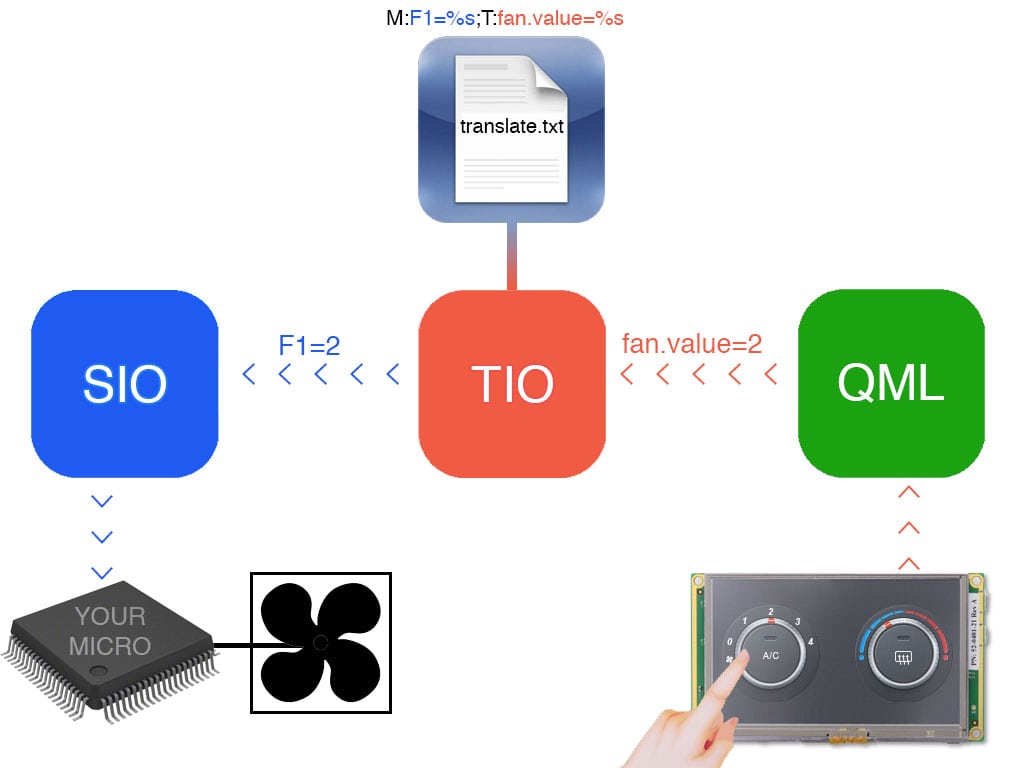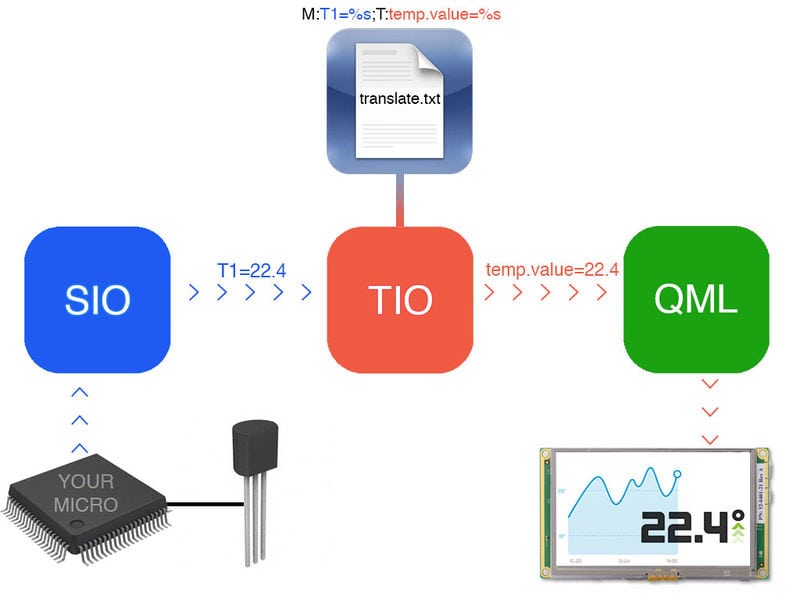Serial to QML Communication
In order for your microcontroller to communicate with the QML Viewer (a tool for loading QML documents that makes it easy to quickly develop and debug QML applications) messages being sent need to be translated. We have created a set of tools called the Serial Input/Output Agent (SIO) and Translator Input Ouput Agent (TIO) agents to make this translation happen.
QML to Serial
Keep in mind that fan.value in this example would be object.propertyName in QML.
Serial to QML
Keep in mind that temp.value in this example would be object.propertyName in QML.
SIO Agent
SIO Agent stands for Serial Input/Output Agent. It is a program that runs in the background and handles serial communication for the Display Module. The SIO Agent passes its output to the TIO Agent which translates the messages into a form that the QML Viewer can understand.
Technical Details
The SIO Agent is installed to /application/bin/sio-agent on the root file system. The agent is started by the init system which executes the /etc/init.d/sio-agent script on start up.
The SIO Agent excepts the following command-line options:
- -b or –baud= – Sets the baud rate used on the serial port. The default is 115200 (8 bits, no parity, one stop bit). The supported baud rates are 115200, 57600, 38400, 19200, 9600 and 1200.
- -d or –daemon – Runs the sio-agent in the background.
- -e or –test – Used for testing.
- -i or –stdio – Uses standard I/O instead of serial port. Mostly used for host development.
- -o or –logfile= – Logs to a file instead of standard error.
- -p or –pty – Uses a pseudo terminal instead of serial port. Mostly used for host development.
- -s[]or –sio_port[=] – Uses a TCP socket instead of domain socket. Default port is 7880.
- -t []or –serial [] – Uses the device . The default is /dev/ttyUSB0.
- -v or –verbose – Prints debug messages.
- -h or –help – Prints usage information.
The startup script can also accept the following commands:
- start
- restart
- stop
TIO Agent
TIO Agent stands for Translator Input Output Agent. Messages sent from the Controller Board and received by the QML GUI should not necessarily be the same, since that would violate a separation of concerns. Messages are translated using Reach’s TIO Agent. The TIO Agent uses a file called translate.txt, which provides a list of translations. The file is typically included in the same folder as the QML application.
Translate.txt File Example
A simple temperature control module has a number with a Celsius temperature, a number with a Fahrenheit temperature, and two buttons to raise and lower the temperature. It is connected to a controller board with a heater and a thermometer. When the thermometer detects a temperature change, it sends the new temperature to the UI for display. When the user presses the “Raise Temperature” or “Lower Temperature”, the UI sends a message to raise or lower the temperature by a specified amount. For such a temperature control panel, the translate.txt file would look like this:
M:celsius_temperature_from_thermometer=%s,T:celsius_display.text=%s M:fahrenheit_temperature_from_thermometer=%s,T:fahrenheit_display.text=%s G:raiseTempTo=%s,T:setTemperature=%s G:lowerTempTo=%s,T:setTemperature=%s
The %s represents the string which will be kept the same during the translation process. M: Represents messages sent from the controller module. G: Represents messages sent from the GUI, in this case the QML Viewer. T: Represents the translation of the previous statement. Each entry must begin with either an M: or G: with a following statement. Then there must be a comma and a T: indicating what the text will be translated to.
M:message_from_controller_board=%s,T:QML_object_name_on_GUI.property=%s G:message_from_GUI=%s,T:value_to_send_controller_board=%s
Technical Details
The TIO Agent runs in the background and accepts inputs from the SIO Agent. The translation table is typically stored with the the application at /application/src/translate.txt. The TIO Agent is installed to /application/bin/tio-agent on the root file system. The TIO Agent is started by the init system which executes the /etc/init.d/tio-agent script on start up.
The TIO Agent excepts the following command-line options:
- -d or –daemon – Runs the tio-agent in the background.
- -f or –file= – Uses for translations.
- -o or –logfile= – Logs to file instead of standard error.
- -r or –refresh= – Auto-refreshs translation file.
- -s[]or –sio-port[=] – Uses TCP socket. Default is 7880.
- -t[]or –tio-port[=] -Uses TCP socket. Default is 7885.
- -v or –verbose – Prints debug messages.
- -h or -? | –help – Prints usage information.
Sending Messages to your Microcontroller
When you need to send messages from your QML application back to your microcontroller, you can use the connection plug-in (specifically, the connection.sendMessage method), as described at QML Viewer Plugins.
Embedded Touchscreens Made Easy:
Up in Days, Smoothly to Production. Get started with a Development Kit.
Reach Technology is now a part of Novanta.
Sales and Engineering
545 First Street
Lake Oswego, OR 97034
503-675-6464
sales@reachtech.com
techsupport@reachtech.com
Manufacturing
4600 Campus Place
Mukilteo, WA 98275
service@reachtech.com
Please send payments to:
Novanta Corporation
PO Box 15905
Chicago, IL 60693
accounts.receivable
@novanta.com


